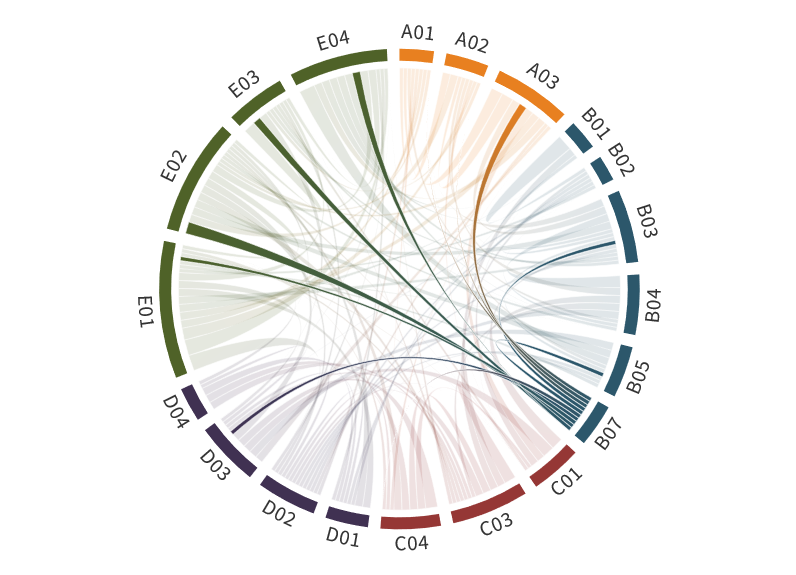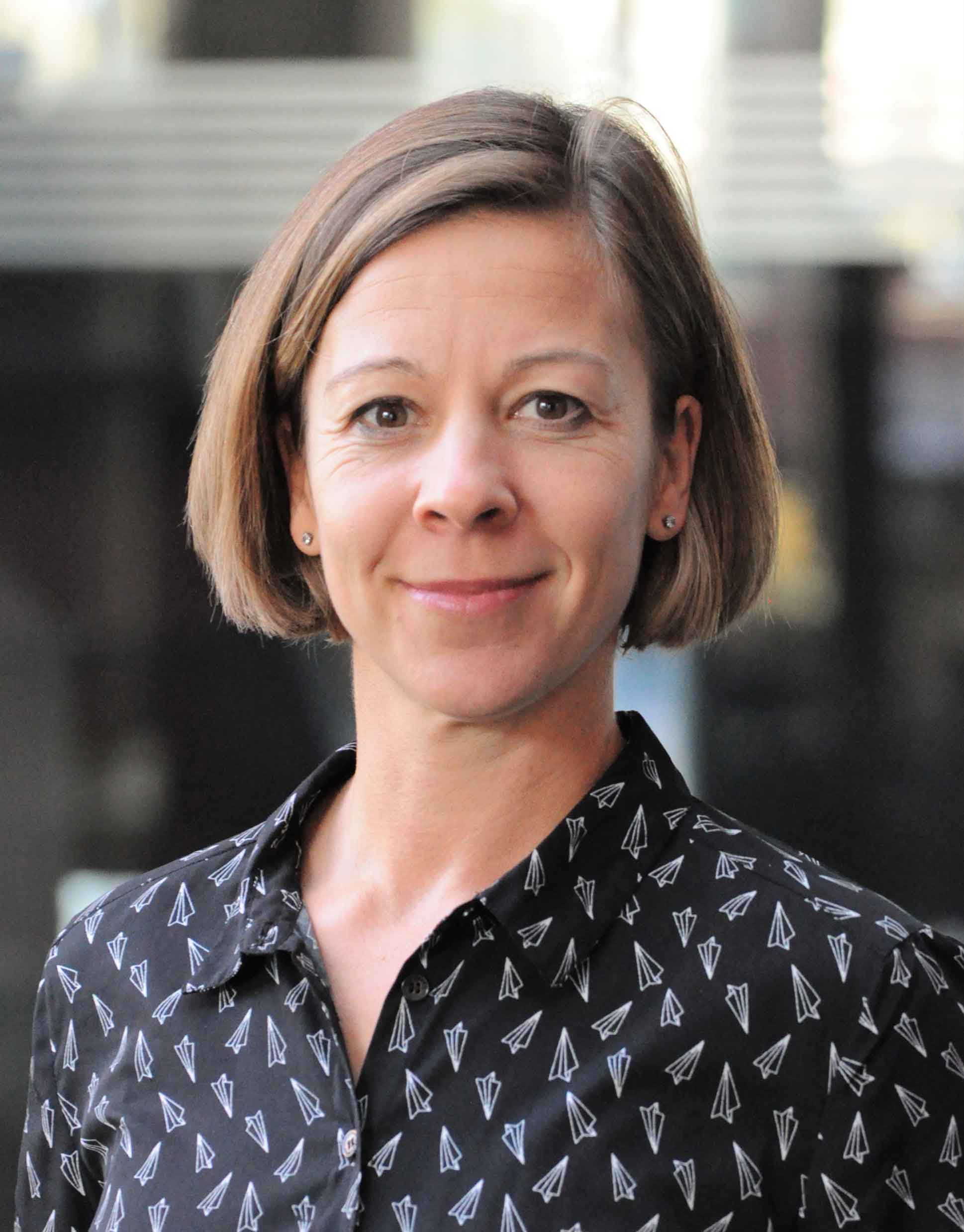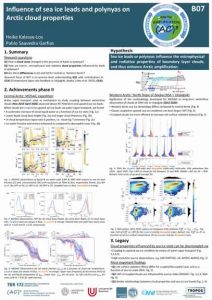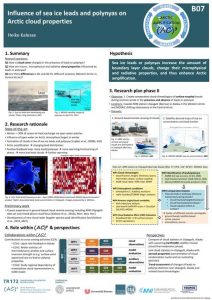B07: Influence of sea ice leads or polynyas on Arctic cloud properties
PROJECT ENDED IN 2023
PIs: Heike Kalesse-Los
As a new project in phase II, the focus was to investigate the characteristics of Arctic cloud properties influenced by sea ice conditions like leads or polynyas. This has been performed based on two cloud observational sites: the Atmospheric Radiation Measurement (ARM)-site at the North Slope of Alaska (NSA) in Utqiaǵvik, Alaska; and the MOSAiC expedition. The first provided a long-term dataset of observations in the Western Arctic, whereas the MOSAiC expedition gave an unprecedented opportunity for the detailed study of the central Arctic due to the extensive suite of ship-based and space-borne observations of clouds and sea ice, respectively.
Firstly, a fundamental task of the project was to develop the climatology of cloud properties and sea ice conditions. Cloud properties have been obtained by adapting the Cloudnet target classification (Illingworth et al., 2007), under its new open-source version CloudnetPy developed by Tukiainen et al. (2020), to be used with the ARM data. This was needed because CloudnetPy does not support ARM data by default. Cloudnet products for NSA have been created for the period from 2012 to 2022. One limitation of Cloudnet is that liquid cloud detection is constrained by the total lidar attenuation at the lowest liquid cloud layer. To partially mitigate this limitation two alternative Cloudnet datasets have been developed based on two different lidar systems: a ceilometer (prone to be more affected by attenuation) and the High Spectral Resolution Lidar (HSRL) with higher sensitivity to detect liquid at upper levels. The dataset for the HSRL, however, is only available for the period 2014 to 2019. Furthermore, NSA ARM data from four wintertime periods (2018-2022) has been specifically processed in order to train a convolution neural network for cloud liquid detection beyond lidar attenuation algorithm (VOODOO) developed by Schimmel et al. (2022). Thus the improvement of the Cloudnet cloud classification by VOODOO can be applied to the ARM instrumentation in general and to Arctic observatories like NSA and MOSAiC in particular.
Secondly, the sea ice conditions around the observational sites have been linked to the cloud observations above the sites. To do that, the water vapor transport (WVT) being conveyed towards the observational site has been exploited as a mechanism to link sea ice condition upwind with the measured cloud properties above the site. This novel methodology is used to classify the observed cloud as coupled or decoupled to the WVT based on the relative location of the maximum vertical gradient of WVT height relative to the cloud mixing layer extending above and below the cloud top and base, respectively. Only a conical sub-sector of sea ice concentration (for NSA and MOSAiC) or lead fraction (for MOSAiC) centered at the observational site and extending up to 50 km radius and azimuth angle governed by the time dependent wind direction measured at the maximum WVT is related to the observed cloud.
Hypothesis:
Sea ice leads or polynyas increase the amount of Arctic boundary layer clouds, change their microphysical and radiative properties, and thus enhance Arctic amplification.
Specifically, we want to study the questions:
- How is cloud cover changed in the presence of leads or polynyas (Q1)?
- How are macrophysical and microphysical cloud properties influenced by leads or polynyas (Q2)?
- Are there differences in Q1 and Q2 for different locations (Central Arctic vs Western Arctic)?
Role within (AC)³
Members
Dr. Pablo Saveedra Garfías
Postdoc
University of Leipzig
Leipzig Insitute for Meteorology (LIM)
Stephanstr. 3
04103 Leipzig
Jun.-Prof. Dr. Heike Kalesse-Los
Principal Investigator
University of Leipzig
Leipzig Insitute for Meteorology (LIM)
Stephanstr. 3
04103 Leipzig
Publications
2024
Pablo Saavedra Garfias, Heike Kalesse-Los, Kerstin Ebell, 2024; Estimation of wintertime cloud radiative effects in the Western Arctic, a function of cloud-moisture-coupling and sea ice conditions. AIP Conf. Proc.; 2988 (1): 070008. https://doi.org/10.1063/5.0182751
Saavedra Garfias, P., H. Kalesse-Los, 2024. Long-term statistical analysis of wintertime cloud thermodynamic phase and micro-physical properties in relation to sea ice condition at NSA Utqiaǵvik site. ESS Open Archive. DOI: 10.22541/essoar.170516166.65463592/v1
Saavedra Garfias, P., H. Kalesse-Los, J. Beikert, T. Seelig, 2024. The role of water vapor transport and sea ice leads on Arctic mixed-phase clouds during MOSAiC. ESS Open Archive. DOI: 10.22541/essoar.170431102.26299753/v1
2023
Saavedra Garfias, P., H. Kalesse-Los, 2023. Wintertime Arctic cloud properties coupled to sea ice leads during MOSAiC expedition. Harvard Dataverse, V1, DOI: 10.7910/DVN/DZSUV7.
Saavedra Garfias, P., H. Kalesse-Los, 2023, J. Beikert. Do sea ice conditions have a measurable influence on snowfall? A study based on MOSAiC wintertime observations. ESS Open Archive. DOI: 10.22541/essoar.169774532.27101629/v1
Saavedra Garfias, P., H. Kalesse-Los, 2023. Variation of cloud properties ascribed by sea ice states in the central and western Arctic. ESS Open Archive. DOI: 10.22541/essoar.169008271.12504472/v1
Saavedra Garfias, P., H. Kalesse-Los, K. Ebell, 2023. Climatology of mixed-phase clouds and their radiative effects when coupled to sea ice; study based from observations at the western Arctic . ESS Open Archive. DOI: 10.22541/essoar.167457993.38674219/v1
Saavedra Garfias, P., H. Kalesse-Los, L. Von Albedyll, H. Griesche, G. Spreen, 2023. Cloud Macro-and Microphysical Properties as Coupled to Sea Ice Leads During the MOSAiC Expedition. ESS Open Archive. DOI: 10.22541/essoar.167397335.54837214/v1
Saavedra Garfias, P., Kalesse-Los, H., von Albedyll, L., Griesche, H., and Spreen, G., 2023: Asymmetries in cloud microphysical properties ascribed to sea ice leads via water vapour transport in the central Arctic, Atmos. Chem. Phys., 23, 14521–14546, https://doi.org/10.5194/acp-23-14521-2023.
Kalesse-Los, H.; Kötsche, A.; Foth, A.; Röttenbacher, J.; Vogl, T. & Witthuhn, J., 2023: The Virga-Sniffer – a new tool to identify precipitation evaporation using ground-based remote-sensing observations, Atmos. Meas. Tech., Copernicus GmbH, 16, 1683–1704, https://doi.org/10.5194/amt-16-1683-2023
Wendisch, M.; Brückner, M.; Crewell, S.; Ehrlich, A.; Notholt, J.; Lüpkes, C.; Macke, A.; Burrows, J. P.; Rinke, A.; Quaas, J.; Maturilli, M.; Schemann, V.; Shupe, M. D.; Akansu, E. F.; Barrientos-Velasco, C.; Bärfuss, K.; Blechschmidt, A.-M.; Block, K.; Bougoudis, I.; Bozem, H.; Böckmann, C.; Bracher, A.; Bresson, H.; Bretschneider, L.; Buschmann, M.; Chechin, D. G.; Chylik, J.; Dahlke, S.; Deneke, H.; Dethloff, K.; Donth, T.; Dorn, W.; Dupuy, R.; Ebell, K.; Egerer, U.; Engelmann, R.; Eppers, O.; Gerdes, R.; Gierens, R.; Gorodetskaya, I. V.; Gottschalk, M.; Griesche, H.; Gryanik, V. M.; Handorf, D.; Harm-Altstädter, B.; Hartmann, J.; Hartmann, M.; Heinold, B.; Herber, A.; Herrmann, H.; Heygster, G.; Höschel, I.; Hofmann, Z.; Hölemann, J.; Hünerbein, A.; Jafariserajehlou, S.; Jäkel, E.; Jacobi, C.; Janout, M.; Jansen, F.; Jourdan, O.; Jurányi, Z.; Kalesse-Los, H.; Kanzow, T.; Käthner, R.; Kliesch, L. L.; Klingebiel, M.; Knudsen, E. M.; Kovács, T.; Körtke, W.; Krampe, D.; Kretzschmar, J.; Kreyling, D.; Kulla, B.; Kunkel, D.; Lampert, A.; Lauer, M.; Lelli, L.; von Lerber, A.; Linke, O.; Löhnert, U.; Lonardi, M.; Losa, S. N.; Losch, M.; Maahn, M.; Mech, M.; Mei, L.; Mertes, S.; Metzner, E.; Mewes, D.; Michaelis, J.; Mioche, G.; Moser, M.; Nakoudi, K.; Neggers, R.; Neuber, R.; Nomokonova, T.; Oelker, J.; Papakonstantinou-Presvelou, I.; Pätzold, F.; Pefanis, V.; Pohl, C.; van Pinxteren, M.; Radovan, A.; Rhein, M.; Rex, M.; Richter, A.; Risse, N.; Ritter, C.; Rostosky, P.; Rozanov, V. V.; Donoso, E. R.; Saavedra-Garfias, P.; Salzmann, M.; Schacht, J.; Schäfer, M.; Schneider, J.; Schnierstein, N.; Seifert, P.; Seo, S.; Siebert, H.; Soppa, M. A.; Spreen, G.; Stachlewska, I. S.; Stapf, J.; Stratmann, F.; Tegen, I.; Viceto, C.; Voigt, C.; Vountas, M.; Walbröl, A.; Walter, M.; Wehner, B.; Wex, H.; Willmes, S.; Zanatta, M. & Zeppenfeld, S., 2023: Atmospheric and Surface Processes, and Feedback Mechanisms Determining Arctic Amplification: A Review of First Results and Prospects of the (AC)³ Project, Bull. Am. Meteorol. Soc., American Meteorological Society, 104, E208–E242, https://doi.org/10.1175/bams-d-21-0218.1
Linke, O., Quaas, J., Baumer, F., Becker, S., Chylik, J., Dahlke, S., Ehrlich, A., Handorf, D., Jacobi, C., Kalesse-Los, H., Lelli, L., Mehrdad, S., Neggers, R. A. J., Riebold, J., Saavedra Garfias, P., Schnierstein, N., Shupe, M. D., Smith, C., Spreen, G., Verneuil, B., Vinjamuri, K. S., Vountas, M., and Wendisch, M., 2023: Constraints on simulated past Arctic amplification and lapse rate feedback from observations, Atmos. Chem. Phys., 23, 9963–9992, https://doi.org/10.5194/acp-23-9963-2023.
Saavedra Garfias, P.; Kalesse-Los, H.; Albedyll, L. V.; Griesche, H. & Spreen, G., 2023: Cloud Macro-and Microphysical Properties as Coupled to Sea Ice Leads During the MOSAiC Expedition, ESS Open Archive, Authorea,Inc., https://doi.org/10.22541/essoar.167397335.54837214/v1
2022
2021
Saavedra Garfias, P., H. Kalesse-Los, 2021, W. Schimmel. Climatology of clouds containing supercooled liquid in the Western and Central Arctic. ESS Open Archive. DOI: 10.1002/essoar.10509918.1
Saavedra Garfias, P., H. Kalesse-Los, 2021. Classification of cloud microphysical properties as a function of sea ice concentration conditions during MOSAiC. ESS Open Archive. DOI: 10.1002/essoar.10509919.1
2020





